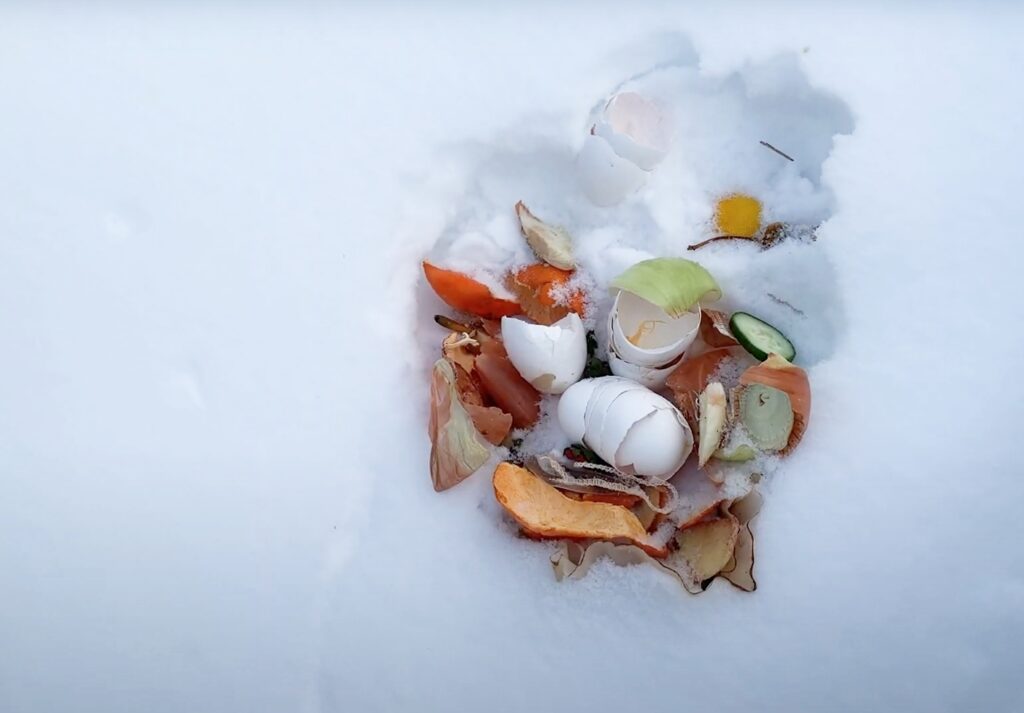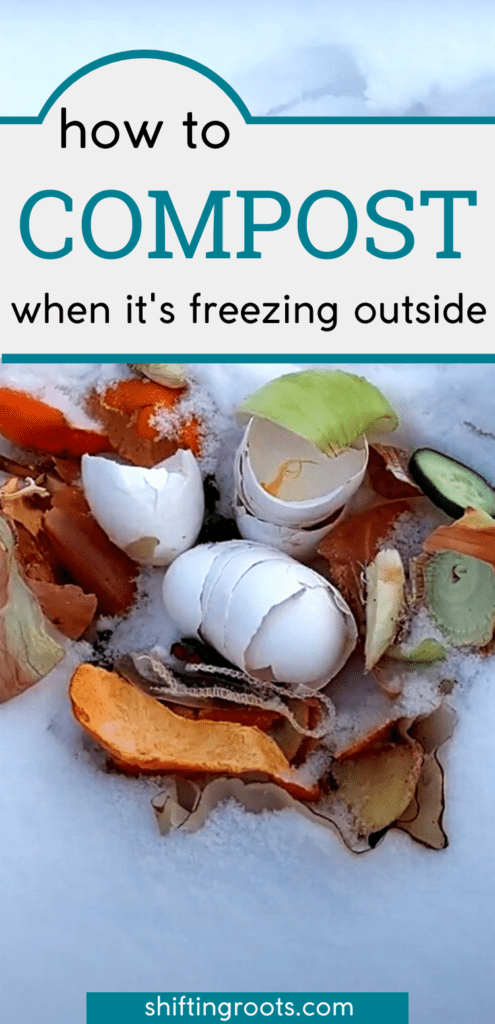We all want to do our part and compost as much as we can. But how do you continue composting in winter, especially if you live in the freezing hinterland that is Canada? Does composting even work in winter? And what about when it’s minus 40 degrees Celcius?!
If you are looking for someone who understands what it’s like to try and continue composting during six long months of winter, you’ve come to the right place. I live in Saskatoon, Saskatchewan, Canada, so I know what it’s like to trudge through 2 feet of snow to the compost bin. So that means those of you in other cold places across North America like Michigan, Colorado, and Wisconsin can also follow these winter composting tips and have success.
By the end of this post, you’ll know how to winter compost, how it works, and what fellow Canadians do when the temperature is unreasonable.
If you’d rather watch than read, watch this video below on winter composting:
CAN YOU COMPOST IN WINTER?
Yes, but it’s probably not what you think. Even though a large compost pile will create a substantial amount of heat, the average household compost pile will freeze during the winter.
Translation: Nothing is happening.
But don’t let that deter you. You can still put all of your household scraps on the compost pile all winter long. When the weather warms up in the spring, the decomposition process will start again and your pile will continue to make black gold.
Before I had a fancy compost bin, I threw my household compost straight on my garden area over the snow all winter long. Sure, it was a bit gross when the snow melted, but I just lightly worked it into the soil as soon as the ground was dry, and the bulk of it decomposed in around 2 weeks.
As long as you don’t throw in any bones or meat (and you shouldn’t be anyway!) rodents shouldn’t be a problem.
HOW DO YOU TAKE CARE OF A COMPOST BIN IN WINTER?
The secret? Do nothing, except add your kitchen scraps to it.
You don’t need to worry about having too many green items in it, because chances are, you loaded up your compost in the fall with lots of browns (leaves, garden waste, etc.). If you’re really worried, you can always turn your compost in the spring as soon as it thaws out.
You also don’t have to worry about mixing the compost in with the snow, scraping snow off, or anything like that. Just dump the kitchen scraps into the compost bin, and let Mother Nature do the work in the Spring. Done.

Want to see our compost bin made out of pallets? Here’s how we made it.
BUT WHAT ABOUT WHEN IT’S FREEZING!?
I’ll admit, I don’t really want to trudge out to the compost bin in -40 either. In that case, the solution is to keep a large plastic container just outside your door to dump all of your compostable items in. They’ll freeze, and when the temperature is slightly more reasonable, move that frozen block of future compost to the main composting area.
Some people do this method the entire winter and never go to the main composting area. The benefit of walking out to your compost tumbler or other composting bin is that these containers often have a much larger capacity than the container placed outside your door. As well, compost tumblers are known to keep compost warmer with proper preparation. Whatever you decide is fine, as long as it eventually goes in the compost bin.
CAN’T I JUST COMPOST INDOORS?
Sure! I personally don’t, because I have toddlers, and things can get messy very fast if I’m not careful. If you can compost indoors, you have a couple of options.
The first: Grab a large plastic bin with a lid and store your compost in there. After every week, sprinkle the contents with a thin layer of peat moss or soil that you’ve either saved from your garden or purchased from a store. You’ll eventually have to empty it out, but you can go a lot longer between those times.
The second: Give more advanced techniques, like vermicomposting or bokashi composting a try. I personally haven’t tried them, so I won’t get into it, but they are two good ways to make your scraps into compost a lot faster.

Related: Compostable Newsprint Pots
Will you give winter composting a try? Any tips to add?
If you liked this blog post, follow me on Facebook, TikTok, and Instagram for more cold-climate gardening tips, delicious recipes, and cut flower goodness! I also make weekly videos over on my YouTube channel. I hope to see you there!
P.S. If you love the content I create for Shifting Roots, consider joining our community on Patreon. Your support means the world to me and I am grateful for each and every one of you!
WANT MORE HELP IN THE GARDEN?
Green thumbs aren’t just given out at birth. They’re a combination of learning about gardening and trial and error. If you wish you knew more about gardening and had more confidence in your abilities, you need the Growing Roots Gardening Guide.
It’s an e-book plus six bonuses. Everything you need to go from complete garden newb to confident gardener in one growing season. Get all the details of what’s inside here.
Happy gardening!




Ruth
William
Lori Napieralski